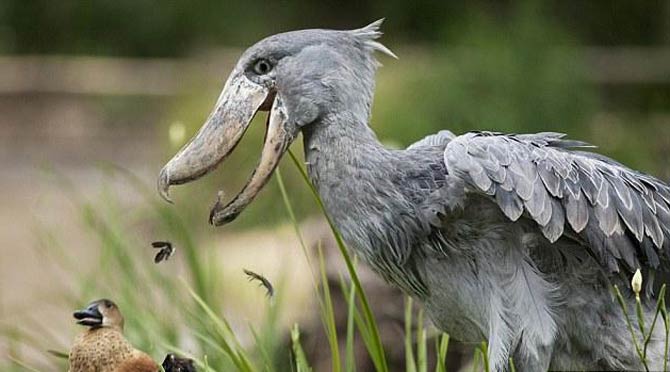Shoebill, whalehead, whale-headed stork, shoe-billed stork
The shoebill is an unusual bird that occurs naturally only in Africa. Its most distinctive feature is a huge beak, which resembles a large, hook-like shoe. Despite its rather menacing appearance, the bird is completely harmless to humans. Researchers observing these birds in their natural environment can approach them at a distance of less than 2 meters (6.5 ft).
Classification
- Kingdom: Animalia
- Phylum: Chordata
- Class: Aves
- Order: Pelecaniformes
- Family: Balaenicipitidae
- Genus: Balaeniceps
- Species: Balaeniceps rex
Initially, shoebills were classified as storks (Ciconiiformes), but the latest research has shown that they are closer to pelicans (Pelecaniformes).
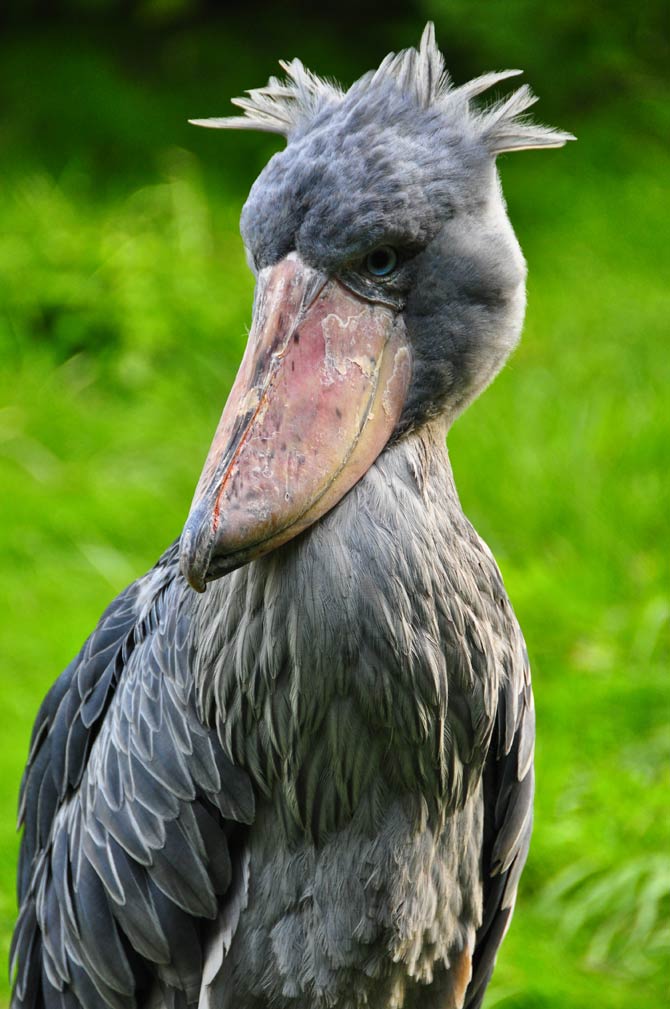
Occurrence
The shoebill is an endemic species to Africa and inhabits the central-eastern part of the continent. So you can meet him in the territory of Sudan, Zambia, Congo, Rwanda, Uganda and western Tanzania. Single specimens have also been observed in Kenya, the Central African Republic, northern Cameroon, southwestern Ethiopia, and Malawi.
The shoebill is not a migratory bird and only moves periodically due to the availability of food or the disturbance of their natural habitat by humans.
However, it does not fly more than 500 meters from its previous location.

Natural environment
Shoebills inhabit vast areas covered with freshwater swamps and those located near rivers and lakes. The appearance of these birds in a given territory strictly depends on the presence of papyrus, cattails and reeds there. They like areas with diverse vegetation the most.
These birds also feed on paddy fields and flooded plantations. They also like to be surrounded by poorly oxygenated waters, because it is easier for them to catch fish that swim close to the surface of the water.
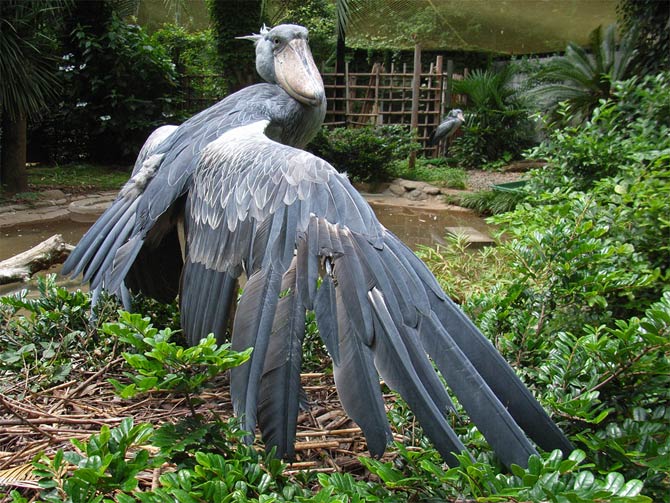
Characteristic
Shoebills with the shape of their body slightly resemble storks. They have a rather massive torso, slender neck and long, thin legs. Their most characteristic feature, however, is an exceptionally large beak, which looks like a wooden shoe. The beak has an elongated, wide shape and a hooked end to make it easier to catch slippery fish and rummage through the mud. It is yellowish in color with small darker spots.
Although the neck of a shoebill appears long and slender, it is actually shorter than that of other wading birds such as herons and cranes.
Shoebill’s eyes are relatively large and set forward, which allows them to see better in 3D. They are yellowish or gray-white in color.
The back and neck of the shoebill are covered with blue-gray feathers with a greenish sheen. The underside of the body is usually lighter in color – often almost white. The head also takes on a grayish hue, however darker than the rest of the body. On its back, there is a bunch of protruding feathers.
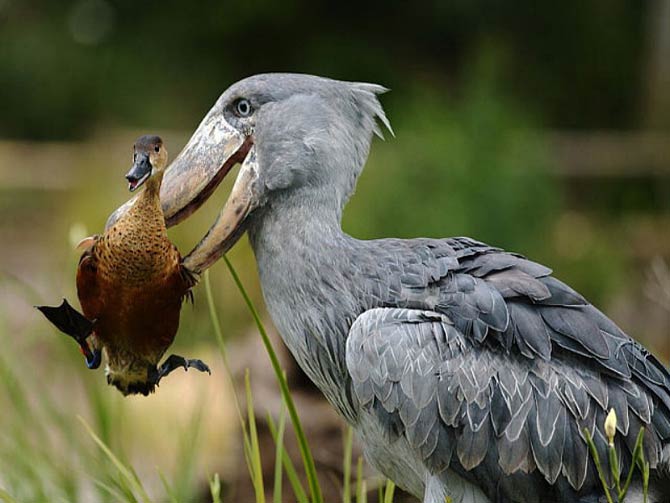
Diet
Shoebills feed mainly in aquatic environments, and a large part of their food is lungfish. They eagerly eat catfish, tilapia and water snakes. The diet of these birds is supplemented by frogs, monitor lizards, turtles, young crocodiles, mollusks and carrion.
The most suitable place for the shoebill to hunt is shallow, poorly oxygenated water and the vicinity of tall vegetation that provides the bird with camouflage.
Shoebill can stand and wait for its prey. They catch it by dropping their neck abruptly towards the water’s surface. Such strikes are repeated several times, but the entire attack lasts no more than 10 minutes.
Fish that are prey to shoebills are usually from 15 to 50 centimeters and weigh up to 500 grams.

Lifestyle
Shoebills lead a solitary lifestyle. They form loose groups only when food is scarce and they are forced to forage next to each other.
They are very docile to people. Researchers observing these birds may approach the nest less than 2 meters (6.5 ft), and the shoebill will not attack them.
It is an active animal at night. As it is very large – it is rare to see it in flight. If it is already flying, it uses air currents for this.

Communication
Shoebill birds are extremely quiet and only sometimes you can hear their characteristic rattling, typical of storks. Adults make this sound, among others to greet each other in the nest, and the cubs to ask for food.
The primary senses a Shoebill uses in a hunt are sight and hearing. To increase its field of view, this bird keeps its head almost vertical – parallel to its breast.
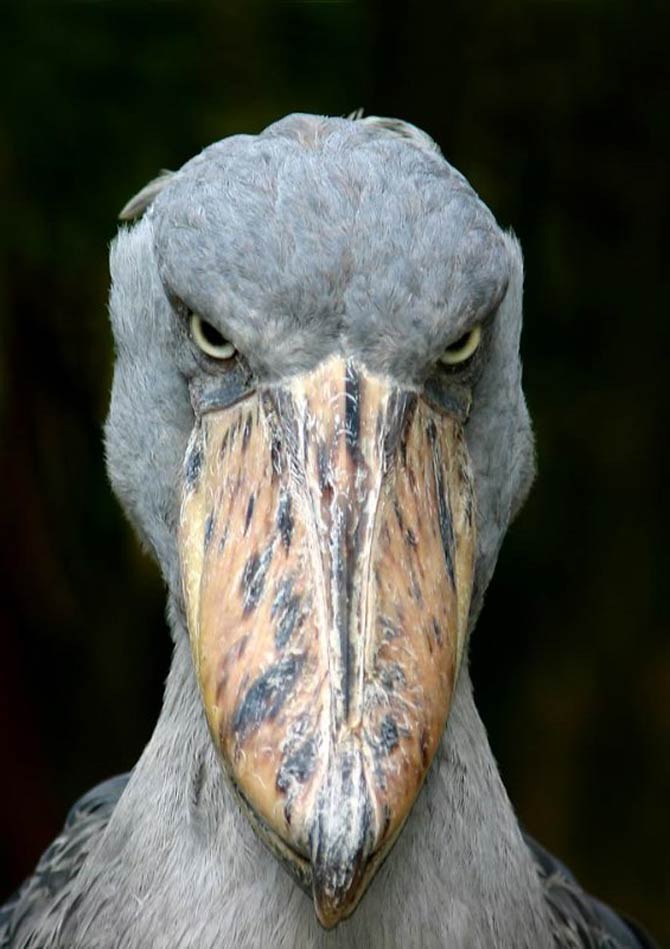
Reproduction
Shoebills – although they are not herding animals – form monogamous pairs during the breeding season, which together build a nest, brood eggs and take care of the young. During this time, these birds fiercely defend their territory against all kinds of threats and predators.
The female lays 1 to 2 eggs, and the incubation period is 30 days. After hatching, adults provide the young with food up to 6 times a day. Small shoebills develop rather slowly compared to other birds. Feathers do not fully develop until 60 days of age. The young learn to fly only 105-112 days after birth.

Detailed data / dimensions (size)
Shoebill (Balaeniceps rex)
Shoebills have sexual dimorphism – males are larger and have longer and more massive beaks.
- Height at the withers: 110 – 140 cm (43 – 55 in)
- the largest specimens reach even 152 cm (60 in)
- Body length (tail to beak): 100 – 140 cm (39 – 55 in)
- Wingspan: 230 – 260 cm (7.5 – 8.5 ft)
- Weight: 4 – 7 kg (8.8 – 15.4 lb)
- males on average: 5.6 kg (12 lb)
- females on average: 4.9 kg (11 lb)
- The average lifespan of a shoebill: 36 years.

Shoebill – interesting facts
- The world population of shoebills ranges from 11,000 to 15,000 individuals. Some sources report a population size of between 5,000 and 8,000, but the figures are rather understated.
- Shoebills are caught and sold as food.
- The natives also receive a lot of money for catching these birds and selling them to zoos. These are the most expensive birds bought for the zoo. Their price ranges from $10,000 to $20,000!
- Birds born in zoos do not want to reproduce.
